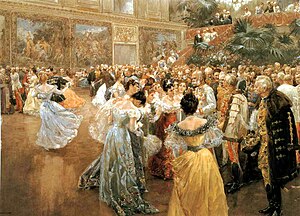First dance
This article needs additional citations for verification. (June 2009) |

The first dance is an element in a number of traditions, being an opening of a certain dance function: ball, prom, etc.
Balls

In the context of balls, the term "first dance" has two meanings.
At various formal balls the first dance was led by the guest of honor, which was usually the person of the highest social position in a given context, such as a member of the royal family, if any were present. Their dance was the opening of the ball. As these were generally long country dances, the guests of honor would be the first people to go down the set, not the only two people dancing for the entirety of the first piece of music.
In 17th-century France, the minuet, also called "the Queen of Dances", was the first dance.
In the Victorian era of Great Britain the first dance was a quadrille.[1]
In 19th century Russian Empire balls were opened with Polonaise.
Another meaning is the first occurrence of a young lady in a social gathering. It could have happened either during a usual ball or during a specially arranged debutante ball or cotillion.
Weddings
The "first dance" of a married couple is a popular element at many post-wedding celebrations in modern European and American traditions. Exactly like an old-fashioned ball, the idea is that the married couple, as the guests of honor at a dance, open the dancing, not that they perform a choreographed duet for spectators.[2] First dances, because they are intended to open the dance for all guests, are inappropriate and therefore omitted when there is no other dancing planned for the guests.
In the past, the first wedding dance was commonly a waltz. In modern times ballroom dancing is no longer a widespread skill, and rehearsing the "first dance" has become a lucrative business for dance studios and independent dance instructors. Today more popular dances include the foxtrot, merengue, and swing. Alternatively, many couples just do a "slow dance". More recently, some couples have been known to introduce a surprise into their dance to shock and humour their audience e.g. by dancing to a song in a mock disco style.[3]
Other
- At "Studniówka", a kind of prom in Poland, the first dance is usually a polonaise, which students usually have to practice before the ball.
Metaphorical use
Since these times the phrase "to open the ball" has become a figure of speech for initiating an activity which will be subsequently continued by others. The term has been used in descriptions of battle scenes.[4]
Notable occurrences
- The first dance of Cinderella was the "first dance" in two senses: it was her first dance, and she was asked to open the ball by the prince
See also
References
- ^ Thomas E. Hill, "Essential Handbook of Victorian Etiquette" (1994) ISBN 0-912517-12-3 (paperback)
- ^ Martin, Judith; Jacobina Martin (2010). Miss Manners' Guide to a Surprisingly Dignified Wedding. New York: W. W. Norton & Company. p. 272. ISBN 0-393-06914-1.
{{cite book}}: CS1 maint: multiple names: authors list (link) - ^ The Brubaker Wedding Dance
- ^ From Rudyard Kipling's "The Drums Of The Fore And Aft": Over that pock-marked ground the Regiment had to pass, and it opened the ball with a general and profound courtesy to the piping pickets; ducking in perfect time, as though it had been brazed on a rod.
